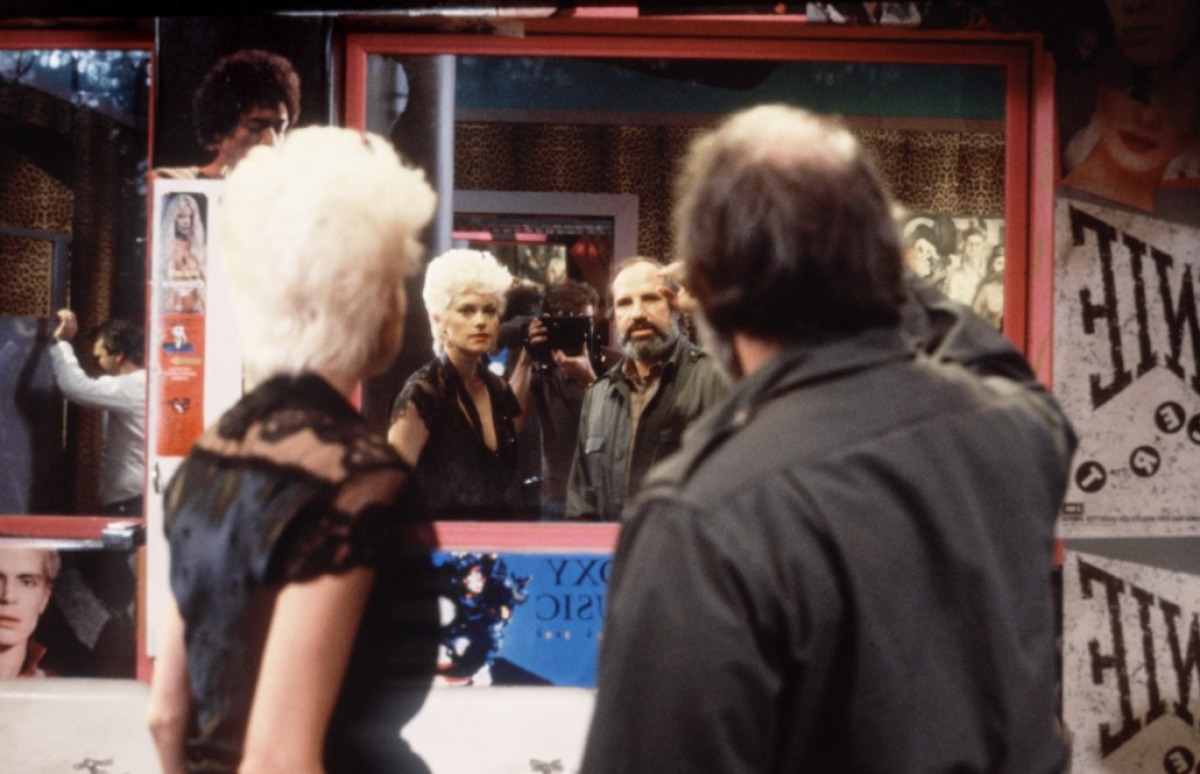by Pauline Kael
If Brian De Palma were a new young director, Body Double would probably be enough to establish him as a talented fellow. In its own terms, this murder mystery set in L.A., in the overlapping worlds of “serious” acting and performing in porno films, is stupid yet moderately entertaining, and it has a tickling performance by Melanie Griffith as Holly Body, a porno star with a punk-vamp haircut and a sprig of holly tattooed on her rump. But, coming from De Palma, Body Double is an awful disappointment: the voyeuristic themes and the scare sequences are so similar to elements of his earlier movies that you keep waiting for the thrills—the moments when he’ll top himself. And he doesn’t. He doesn’t equal himself, either. He stages the big scenes mechanically, without the zest that used to send them off to horror-comedy heaven. He has grown past this material, and he must know it. (According to his statements in the press, he took on the directing end of this project, which he had been scheduled to produce, only after repeated failures to raise money for projects he had prepared—one on the Yablonski murders, with a script he wrote with Scott Spencer, and one on a rock star like Jim Morrison, with John Travolta in the part.)
The central role here is played by Craig Wasson, which is the worst piece of casting in a De Palma movie since Cliff Robertson stared at the camera and drifted through Obsession. Wasson may, in a sense, seem right for the part—a clean-cut, not too bright young L.A. actor who easily slips into voyeurism and fetishism—but what makes him seem right for it is what makes him too bland to play it. He looks like the kind of guy who as a kid had an old man’s face and was always praised for being mature. Whatever Wasson does, he’s dead earnest about it, and his conscientious acting is a drag on the movie. Dennis Franz plays the horror-film director who fires Wasson from his job as the vampire in Vampire’s Kiss for the very good reason that the claustrophobic Wasson is paralyzed with fear if he’s put in a tomb. Franz does his scuzzo number: the guy who’s so blatantly uncouth he’s funny—only this time he isn’t. The movie has no center, and it’s a washout until Holly Body arrives, close to the midway point; we were waiting for something, and she turns out to be it.
Double-entendres in the movies used to be labored; here it’s as if the atmosphere around Holly—where she works, what she does—were so porny that she couldn’t talk except in double-entendres. She’s like a dirty-minded teen-age seductress, and what she says has an element of surprise even for her; her talk is so sexy it gives her ideas and drives her eyebrows up. De Palma’s affection for funkiness makes Melanie Griffith’s performance possible, and in scenes such as Holly’s barging into the middle of traffic trying to hail a taxi De Palma gets a fresh visual quality, too. Most of the film’s best moments have to do with actors and actors’ lives; there’s a sisters-under-the-skin moment when Holly Body meets a “serious” actress who’s looking for a job, and tries to be helpful, neither of them realizing that they’re not in the same line of work. (It’s like the wonderful fluke encounters in early De Palma films, such as Hi, Mom!)
But the big, showy scenes recall Vertigo and Rear Window so obviously that the movie is like an assault on the people who have put De Palma down for being derivative. This time, he’s just about spiting himself and giving them reasons not to like him, And these big scenes have no special point, other than their resemblance to Hitchcock’s work. Crude, real fears were addressed in De Palma’s earlier films. Phantom of the Paradise made everything you’d heard about the rock industry as a gigantic casting couch come true, Carrie was about the dread of menstruation, Dressed to Kill was about your qualms that sexual pleasure would get you into trouble, Blow Out was about your apprehensions that you were a coward and would fail those who counted on you, and so on. But Body Double has no subject other than the plot contraption that De Palma and his co-writer, Robert J. Avrech, thought up—unless there are a lot of claustrophobes in the audience. The only thing that’s new here in terms of getting at deeper fears is the dirt flung onto (living) people in graves, and that isn’t particularly well worked out.
Body Double is not, to put it mildly, a spirited piece of moviemaking. It features (on a character called “the Indian”) the worst makeup job of recent times. And the score (by Pino Donaggio) seems to have been ladled over the images. (The thought of what some of the scenes might have been like without it is a little frightening.) There’s a key difference between this picture and good De Palma. In Carrie, when the camera moves languorously around teen-age girls in a high-school locker room there’s a buzz between the camera and what it’s filming. But here De Palma and his cinematographer, Stephen H. Burum, get away from the out-of-work actors’ low-rent apartments and the litter of pizza rinds very quickly. De Palma saves the languorous camera for the sleek, expensive settings, such as the Beverly Hills shopping mall called the Rodeo Collection, and there’s not only no comic buzz—the camera seems wowed, impressed. The voyeuristic sequences, with Wasson peeping through a telescope, aren’t particularly erotic; De Palma shows more sexual feeling for the swank buildings and real estate.
The New Yorker, November 12, 1984






1 thought on “Body Double (1984) – Review by Pauline Kael”
Post reviews of The Last American Hero (1973) with Jeff Bridges.